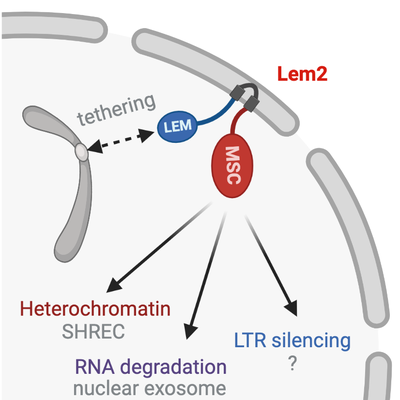Regulation of gene repression at the nuclear periphery
The nuclear periphery provides a specialized subcompartment that promotes the establishment and maintenance of silent chromatin by recruiting chromatin and components of the silencing machinery to the nuclear envelope. This is believed to increase their local concentration and contribute to their specificity.
We demonstrated that the conserved inner nuclear membrane protein Lem2 contributes to heterochromatin silencing and perinuclear localization of centromeres, which can be mechanistically dissected and is mediated by different protein domains of Lem2 (Barrales et al., Genes Dev 2016). Beyond heterochromatin, we found that Lem2 contributes to RNA degradation (Martin Caballero et al., Nature SMB 2022) and retrotransposon silencing, indicating that plays a central role in coordinating multiple nuclear functions at the nuclear periphery both at the transcriptional and post-transcriptional level. Heterochromatin silencing is mediated through the recruitment of a Snf2-like nucleosome remodelling/histone deacetylate repressor complex (SHREC, a homolog of mammalian NuRD), which binds to the MSC domain of Lem2. In analogy, RNA turnover is promoted through the recruitment of MTREC (homolog of human PAXT) mediating the targeting of RNAs to nuclear exosome, which is the main route of nuclear RNA degradation in eukaryotes. How are retrotransposons are silenced by Lem2 is currently unknown.

